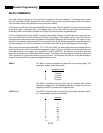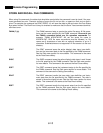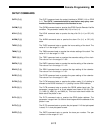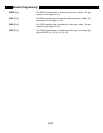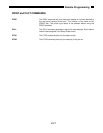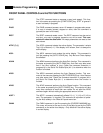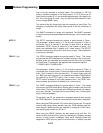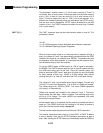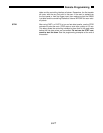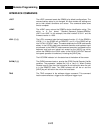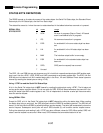
6-24
Remote Programming
and θ are also recorded at a single instant. Thus reading X,Y OR R,θ
yields a coherent snapshot of the output signal. If X,Y,R and θ are all
read, then the values of X,Y are recorded approximately 10µs apart from
R,θ. Thus, the values of X and Y may not yield the exact values of R and
θ from a single SNAP? query.
The values of the Aux Inputs may have an uncertainty of up to 32µs. The
frequency is computed only every other period or 40 ms, whichever is
longer.
The SNAP? command is a query only command. The SNAP? command
is used to record various parameters simultaneously, not to transfer data
quickly.
SPTS ? i The SPTS? command queries the number of points stored in Trace i.
The parameter i selects a trace (1, 2, 3 or 4) and is required. If Trace i is
not stored, then 0 is returned. If the scan is reset, then 0 is returned.
Remember, SPTS? returns N where N is the number of points - the
points are numbered from 0 (oldest) to N-1 (most recent). The SPTS?i
command can be sent at any time, even during a scan. This command is
a query only command.
TRCA ? i, j, k The TRCA? command queries the points stored in Trace i. The values
are returned as ASCII floating point numbers with the units of the trace.
Multiple points are separated by commas and the final point is followed
by a terminator. For example, the response with two points might be
"-1.234567e-009,+7.654321e-009,".
The parameter i selects a trace (1, 2, 3 or 4) and is required. If Trace i is
not stored, then an error occurs. Points are read from the buffer starting
at bin j (j≥0). A total of k bins are read (k≥1). To read a single point, set
k=1. Both j and k are required. If j+k exceeds the number of stored points
(as returned by the SPTS? query), then an error occurs. Remember,
SPTS? returns N where N is the total number of bins - the TRCA? com-
mand numbers the bins from 0 (oldest) to N-1 (most recent).
TRCB ? i, j, k The TRCB? command queries the points stored in Trace i. The values
are returned as IEEE format binary floating point numbers (with the units
of the trace). There are 4 bytes per point. Multiple points are not separat-
ed by any delimiter. The bytes can be read directly into a floating point
array (in most languages).
Do not query the IFC (no command in progress) status bit after sending
the TRCB command. This bit will not be set until the transfer is complete.
When using the GPIB interface, EOI is sent with the final byte. The points
must be read using a binary transfer (see your GPIB interface card soft-
ware manual). Make sure that the software is configured to NOT termi-
nate reading upon receipt of a CR or LF.
When using the RS232 interface, the word length must be 8 bits. The
points must be read as binary bytes (no checking for linefeeds, carriage
returns or other control characters). Most serial interface drivers are
designed for ASCII text only and will not work here. In addition, the data



